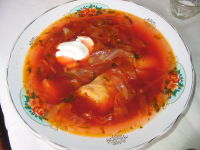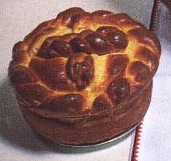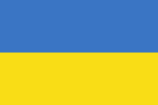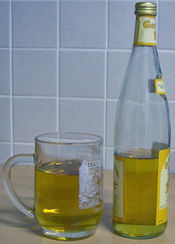Ukrainian cuisine

An Olivier salad
Ukrainian cuisine has a rich history and offers a wide variety of dishes. Ukrainian cuisine is rich in taste and nutritional value.
Popular dishes
Soup

Ukranian Borscht, made from beetroots and other vegetables, with meat.
- Borsch (borshch): vegetable soup made out of beets, cabbage, potatoes,tomatoes, carrots, onions, garlic, dill, sometimes green pepper, served with sour cream.
- Kapusniak soup made with pork, salo (pork fat),sauerkraut and served with sour cream
- Rosolnyk: soup with pickles.
- Yushka: fish soup, made of fresh-water fish, usually carp. Similar to the Russian cuisine, Uha, which is also a fish-soup.
Salads
- Olivye (Salade Olivier): salad made out of cooked and chopped potatoes,dill pickles,broiled chopped eggs,cooked and chopped chicken,onions,mixed with mayonnaise.
- Vinigret (from French Vinaigrette): salad with cooked and shredded beets, sauerkraut,cooked and chopped potatoes, onions and carrots,sometimes pickles mixed with some sunflower oil and salt.
- Pickles: Pickled cucumbers (kvasheni ohirky) or tomatoes (kvasheni pomidory) are usually made with garlic and dill. Also, sauerkraut (kvashena kapusta).
Breads

Easter Paska
Breads and wheat products are very important to Ukrainian cuisine. Decorations on the top can be very elaborate for celebrations.
- Paska: traditional rich Easter bread. It is shaped in a short round form. The top of the paska is decorated with typical Easter symbols, such as roses or crosses.
- Babka: another Easter bread, usually a sweet dough with raisins and other dried fruit. It is usually baked in a tall, cylindrical form.
- Kolach: ring-shaped bread typically served at Christmas and funerals. The dough is braided, often with three strands representing the Holy Trinity. The braid is then shaped into a circle (circle = kolo in Ukrainian) representing the circle of life and family.
- Korovai: a round, braided bread, similar to the kolach. It is most often baked for weddings and its top decorated with birds and periwinkle.
- Palyanytsya
Main course

Roast meat

Deruny or draniki are potato pancakes, here in a traditional crockery dish.
- Perohy: Dumplings stuffed with fillings such as potato and cheese, often served boiled.
- Varenyky: small pastries made with any filling such as mushed potatoes and fried onions, ground meat and fried onions,liver and fried onions,fried cabbage with fried onions, cherries, strawberries. Served with sour cream and butter or sugar when filled with fruits.
- Pyrizhky: Small potato filled buns baked in thickened rich cream and dill.
- Cabbage rolls (holubtsi): cabbage leaves rolled with meat and rice filling stewed in tomato sauce ,served with sour cream.
- Syrnyky: cottage cheese fritters, sometimes with raisins, served with sour cream and jam.
- Mlyntsi: crepes (blyntsi or nalisnyky), filled usually with cottage cheese, meat, cabbage, fruits, served with sour cream.
- Stuffed duck or goose with apples.
- Roast meat (pechenya): pork, veal, beef or lamb roast.
- Fish (ryba): fried in egg and flour; cooked in oven with mushrooms, cheese and lemon; marinaded, dried or smoked variety.
- Studenetz: jellied fish (zalyvne) or meat (kholodets).
- Kasha hrechana zi shkvarkamy: buckwheat cereal with chopped, fried bacon and/or onion.
- Potato (kartoplia, also barabolia or bulba): young or peeled, served with butter, sour cream, dill; a more exclusive variety includes raw egg.
- Guliash: refers to stew in general, or specifically Hungarian goulash.
- Sausage (kovbasa or sosysky): various kinds of smoked or boiled pork, beef or chicken sausage.
- Salo: salted (or occasionally raw) unrendered pork fat lard.
- Kotlety (cutlets): (plural; singular: kotleta) minced meat or fish mixed with eggs,onions, garlic, breadcrumbs and milk,fried in oil sometimes rolled in breadcrumbs.
- Deruny: potato pancakes, usually served with rich servings of sour cream.
chive potatoe cakes its a fried potaoe slices with chives
Desserts

Syrniki, fried quark cheese pancakes, garnished with sour cream, jam, honey, or apple sauce.
- Kutia: traditional Christmas dish, made of poppy seeds, wheat, nuts, honey, and delicacies.
- Pampushky: fried, rich sweet dough similar to doughnut holes. Frequently tossed with cinnamon sugar. Pampushky (pl., singular is pampusho'k) can also be filled with poppy seed or other sweet fillings.
- Syrnyky: fried curd fritters.
- Torte: many varieties of cakes, from moist to puffy, most typical ones being Kyjivskyj, Prazhskyj, and Trufelnyj. They are frequently made without flour, instead using ground walnuts or almonds.
- Zhele: (plural and singular) jellied fruits, like cherries, pears, etc. or Ptashyne moloko (literally ‘birds' milk’)—milk/chocolate jelly.
Beverages
Alcoholic
- Strong spirits (горілка, horilka, водка, vodka in Russian): самогон Samohon (moonshine) is also popular, including with infusions of fruit, spices or hot peppers.
- Beer (пиво, pyvo): the largest producers of beer are Obolon, Lvivske, Chernihivske, Slavutych, Sarmat and Rogan, which partly export their products.
- Wine (вино, vyno): from Europe and Ukraine (particularly from Crimea).
- Mead (мед, med, or медовуха, medovukha): a fermented alcoholic beverage made from honey, water, and yeast. Its flavour depends on the plants frequented by the honeybees, the length of time and method of aging, and the specific strain of yeast used. Its alcohol content will vary from maker to maker depending on the method of production.
Non-alcoholic
- Kompot (компот): a sweet beverage made of dried or fresh fruits and/or berries boiled in water.
- Uzvar (узвар): a traditional compote made of dried fruit, mainly apples, pears and prunes.
- Kvas (квас): a sweet-and-sour sparkling beverage brewed from yeast, sugar and dried rye bread.
- Kefir (кефір): milk fermented by both yeast and lactobacillus bacteria and having a similar taste to yoghurt. Homemade kefir may contain a slight amount of alcohol.
- Mineral water: well-known brands are Truskavetska, Morshynska and Myrhorodska. They usually come strongly carbonated.
- Ryazhanka (ряжанка): another kind of natural yoghurt made of baked milk.
Ukrainian-Canadian cooking
Ukrainian settlers from Galicia and Bukovyna arrived in Canada in the late 1890s. Many of the ingredients they had been used to cooking with (such as wheat flour, barley, rye, cabbage, and root vegetables) could be grown in their new land, but others could not. Although the parklands of the Prairie Provinces were fertile, they were also much further north and higher in altitude than the settlers' old homeland, and the growing season was consequently much shorter.[1] This made the cultivation of crops such as buckwheat, plums, grapes, nuts, and poppies difficult if not impossible. The shorter growing season also meant that the traditional spring and autumn festivals meant to celebrate the beginning and end of the growing season often fell in the dead of winter. In addition, the semi-arid climate reduced the amount of honey and mushrooms available.
The settlers adapted to local conditions, substituting available ingredients for those not obtainable. Dried fruit such as prunes and raisins were used instead of fresh; short-season vegetables such as tomatoes and peppers were incorporated into recipes. Meats such as turkey, goose, duck, and local species of fish were originally used in substitution for pork, as there were initially few pork producers; later on, the immense amount of beef available on the Western Canadian (and especially the Alberta) market and its correspondingly low price meant that Ukrainian cooks were more likely to cook with beef than with pork or, especially, lamb. Attempts, many successful, were made to cultivate traditional ingredients such as poppy seed, honey, and mushrooms; once the settlers had begun to sell their grain crops and had ready cash, they often imported these items from further East as well.
These changes are evidenced in Ukrainian Canadian cuisine. Cabbage rolls or holubtsi may be made from parboiled or pickled cabbage leaves—both fresh and pickled whole cabbage is available in almost all supermarkets on the Prairies—but the most common filling is a mixture of ground beef and rice, with pork a less common substitute. The rolls are often cooked in a tomato sauce which may be flavoured with peppers. Perogies (the standard Canadian English word for varenyky) are usually filled with a combination of potato, onion, and Canadian-made cheeses such as Cheddar, Colby, or Monterey Jack, but are rarely filled with fruit or grains. (The popularity of perogies reaches far beyond the Ukrainian Canadian community; most supermarkets carry a dozen or more different kinds of mass-produced frozen perogies, and they are a common side dish.) Borscht may be beet or tomato-based. Desserts are less likely to be made primarily from ground nuts, and may instead be made from plain flour. Ukrainian sausage (known as kubasa) is heavily seasoned with garlic and Hungarian paprika and is used both in home cooking, restaurant cooking, and even fast food.
See also
- Culinary arts
- Mushroom picking in Slavic culture
- Twelve-dish Christmas Eve supper
Notes
- ↑ The growing season (or frost-free period) at Lviv is over 200 days; the growing season at Edmonton is under 100 days and that at Calgary well under 70 days.
References
External links
 Ukraine topics Ukraine topics |
|
| History |
|
|
| Politics |
|
|
| Law |
Constitution · Judicial system (Constitutional Court · Supreme Court · Prosecutor General) · Law enforcement · Nationality law (citizenship · passport) · LGBT rights
|
|
| Military |
General Staff · Air Force · Ground Forces · Navy · Military Intelligence Service
|
|
| Subdivisions |
Territories (by area · by population · by income) · Raions · Cities · Urban-type settlements
|
|
| Economy |
|
|
| Demographics |
Languages (Ukrainian, Crimean) · Religion · People (list) · Rus' people · Diaspora · 2001 census · Education · Health
|
|
| Culture |
Architecture · Cinema · Cuisine (Wine) · Dance · Literature · Media · Music · Religion · Sport · Television
|
|
| WikiProject · Portal |
|
|
European cuisine |
|
Sovereign
states |
Albania · Andorra · Armenia1 · Austria · Azerbaijan1 · Belarus · Belgium · Bosnia and Herzegovina · Bulgaria · Croatia · Cyprus1 · Czech Republic · Denmark · Estonia · Finland · France · Georgia1 · Germany · Greece · Hungary · Iceland · Ireland · Italy · Kazakhstan2 · Latvia · Liechtenstein · Lithuania · Luxembourg · Macedonia · Malta · Moldova · Monaco · Montenegro · Netherlands · Norway · Poland · Portugal · Romania · Russia2 · San Marino · Serbia · Slovakia · Slovenia · Spain · Sweden · Switzerland · Turkey2 · Ukraine · United Kingdom (England • Northern Ireland • Scotland • Wales)
|
|
States with limited
recognition |
Abkhazia1 · Kosovo · Nagorno-Karabakh Republic1 · Northern Cyprus1 · South Ossetia1 · Transnistria
|
|
Dependencies,
other territories |
Adjara · Akrotiri and Dhekelia1 · Åland · Azores · Faroe Islands · Gagauzia · Gibraltar · Guernsey · Jan Mayen · Jersey · Madeira · Isle of Man · Nakhchivan1 · Svalbard · Vojvodina
|
|
| 1 Partially or entirely in Asia, depending on the border definitions. 2 Transcontinental country. |
|
|
Cuisine (Outline of cuisines) |
|
| Regional |
African · Arab · Asian · Caribbean · Eastern European · European · Lappish Latin American · Mediterranean · Middle Eastern · North African · North American · South American · South Asian · West African
|
|
| National |
Algerian · American · Argentine · Armenian · Australian · Austrian · Bahraini · Belarusian · Belgian · Belizean · Bosnian · Botswanan · Brazilian · British · Bulgarian · Burkinabe · Cambodian · Cameroonian · Canadian · Chilean · Chinese · Congolese · Colombian · Croatian · Cuban · Cyprus · Czech · Danish · Dutch · Ecuadorian · Egyptian · Equatorial Guinea · Estonian · Ethiopian · Filipino · Finnish · French · Georgian · German · Greek · Guatemalan · Honduran · Hungarian · Icelandic · Indian · Indonesian · Iranian · Iraqi · Irish · Israeli · Italian · Jamaican · Japanese · Jordanian · Kazakhstan · Korean · Kuwaiti · Lao · Latvian · Lebanese · Libyan · Lithuanian · Luxembourgian · Macedonian · Malagasy · Malaysia · Maltese · Mexican · Moldovan · Mongolian · Moroccan · Native American · Norwegian · Omani · Palestinian · Pakistani · Peruvian · Polish · Portuguese · Qatari · Romanian · Russian · Salvadoran · Saudi Arabian · Sicilian · Serbian · Singaporean · Slovak · South African · Spanish · Sri Lankan · Sudanese · Swazi · Swedish · Swiss · Syrian · Taiwanese · Thai · Tunisian · Turkish · Trinidadian · Ukrainian · United Arab Emirati · Uruguayan · Venezuelan · Vietnamese · Yemini
|
|
| Historical |
Ancient Egyptian · Ancient Greek · Ancient Roman · Andean · Aztec · Byzantine · Early modern European · Historical Chinese · Historical Indian · Mayan · Medieval · Ottoman
|
|
| Styles |
|
|
| Types of food |
|
|
| Carbohydrate staples |
|
|
| Types of dish |
|
|
| Technical |
|
|
| See also |
|
|



